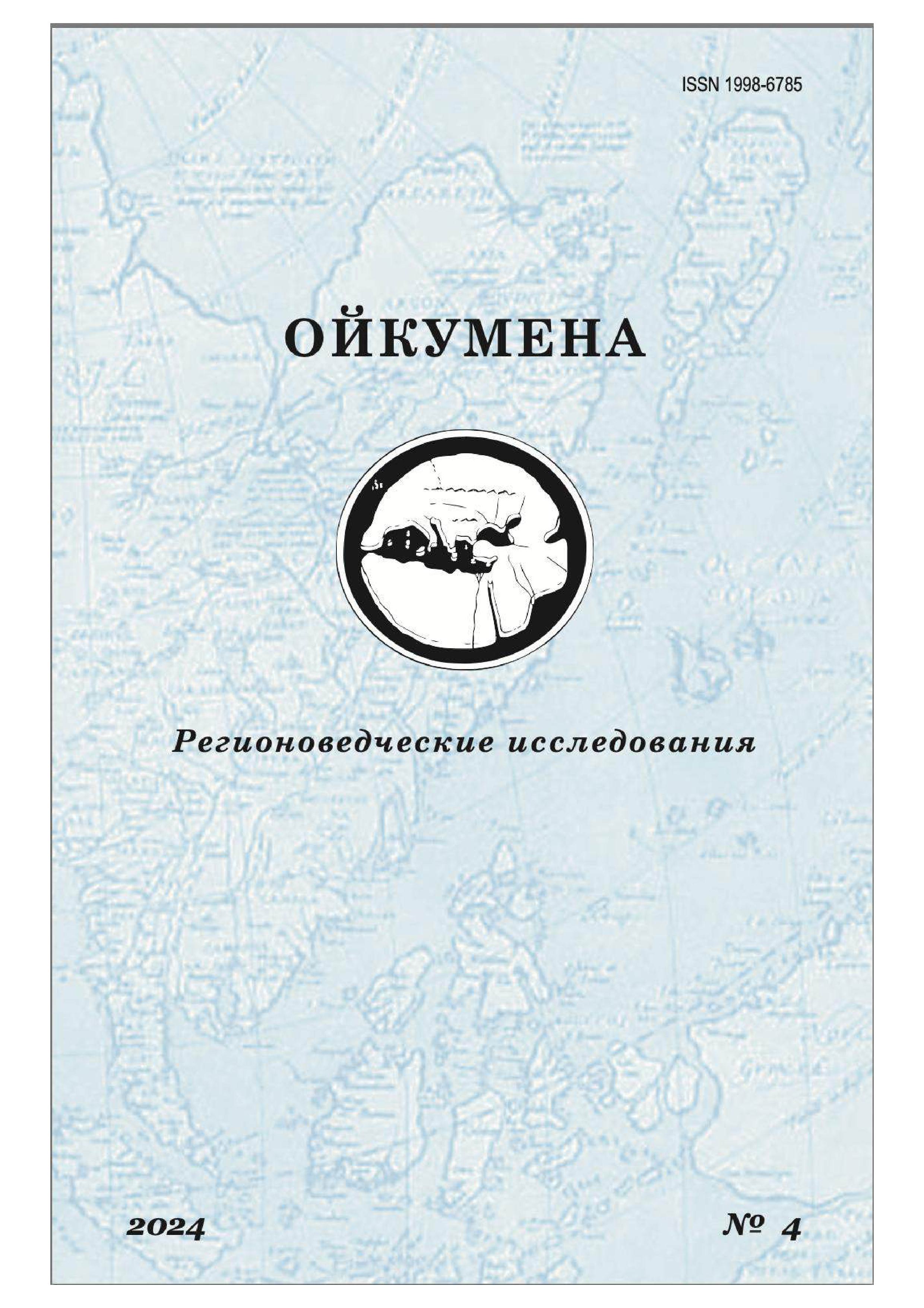Приграничная торговля на рубеже XX–XXI вв. стала заметным фактором развития приграничных регионов Китая. Чтобы воспользоваться географическим преимуществом, китайские власти создали специаль- ный институт ("приграничный пояс открытости"), который позволил выстроить торговые каналы, простирающи- еся далеко за пределы китайских границ. Сопредельные страны (от Северной Кореи до Мьянмы) вынуждены были реагировать на китайские инициативы. Некоторые из них даже создали свои зеркальные институты. Но публикации, оценивающие результаты, пессимистичны: в отличие от Китая, его сопредельным странам редко удавалось достичь успеха. В статье предложено использовать концепцию интернализации правил для осмысления двусторонних результатов.
приграничная торговля, базары, интернализация правил, неолиберализм, неформальная экономика, приграничный пояс открытости, Россия, Китай, Вьетнам
1. Дятлов В. И., Григоричев К. В. Этнические рынки в России: пространство торга и место встречи. Иркутск: Изд-во ИГУ, 2015. 343 с. EDN: https://elibrary.ru/VWQQEZ
2. Романов П. В., Ярская-Смирнова Е. Р. Фарца: Подполье советского общества потребления // Неприкосновенный запас. 2005. Т. 43. № 5. С. 62–68. EDN: https://elibrary.ru/XAUTCZ
3. Рыжова Н. Экономическая интеграция приграничных регионов. Хабаровск: ИЭИ ДВО РАН, 2013. 352 с.
4. Рыжова Н. П. Развитие окраинных регионов КНР: роль "приграничного пояса открытости"// Пространственная экономика. 2008. № 4. С. 36–59. EDN: https://elibrary.ru/KVOZYF
5. Рыжова Н. П. Роль приграничного сотрудничества в развитии окраинных городов Китая и России // Проблемы Дальнего Востока. 2009. № 4. С. 59–74. EDN: https://elibrary.ru/MNGUUX
6. Твердюкова Е. Окно в капитализм, или Чёрный рынок по-советски // Живая история. 2017. № 10. URL: https://lhistory.ru/statyi/okno-v-kapitalizm (дата обращения: 20.10.2024).
7. Billé F. Sinophobia. Anxiety, Violence and the Making of Mongolian Identity. University of Hawaii press, 2014. 268 p.
8. Byler D. Terror Capitalism: Uyghur Dispossession and Masculinity in a Chinese City. Durham: Duke University Press Books, 2022. 296 p.
9. Chan Y. W., Womack B. Not merely a border: borderland governance, development and transborder relations in Asia // Asian Anthropology. 2016. Т. 15. № 2. P. 95–103.
10. Geng X. Basic Facts on Various Development Zones in the Border Provinces and Regions of China // Policy and Management Mechanisms for Economic Development Areas. Urumqi, Xinjiang Uygur Autonomous Region. People’s Republic of China: 22–24 August 2007. www.adb.org
11. Grant A. Crossing Khorgos: Soft power, security, and suspect loyalties at the Sino-Kazakh boundary // Political Geography. 2020. Т. 76. P. 102–070. DOI: https://doi.org/10.1016/j.polgeo.2019.102070; EDN: https://elibrary.ru/ZOLMDZ
12. Grillot C. Chapter Twelve. Arbitrage over the Beilun/ Kalong River: Chinese Adjustments to Border Trade Practices in Vietnam // Traders in Motion: Identities and Contestations in the Vietnamese Marketplace / ed. K. W. Endres, A. M. Leshkowich. Cornell University Press, 2018. P. 185–200.
13. Laungaramsri P. China in Laos: Enclave spaces and the transformation of borders in the Mekong Region // The Australian Journal of Anthropology. 2019. Т. 30. № 2. P. 195–211.
14. Laungaramsri P. Commodifying Sovereignty: Special Economic Zones and the Neoliberalization of the Lao Frontier // Impact of China’s Rise on the Mekong Region / ed. Y. Santasombat. New York: Palgrave Macmillan US, 2015. P. 117–146.
15. Littleton C., Nyiri P. Dams, casinos, and concessions: Chinese mega-projects in Laos and Cambodia // Engineering Earth: The Impacts of Megaengineering Projects / ed. S. D. Brunn. London; New York: Springer-Verlag, 2011. P. 1243-1265.
16. Martin M. Hundi/Hawala: // Modern Asian Studies. 2009. Т. 43. № 4. P. 909–937.
17. Official presentation of the Administration of the Zamyn-Ude Free Economic Zone // CAREC. URL: https://www.carecprogram.org/uploads/Session2.4-Zamyn-Uud-Free-Economic-Zone.pdf (дата обращения: 01.09.2022).
18. Official presentation of Altanbulag Free Economic Zone Administration // Altanbulag Free Economic Zone Administration. URL: https://altanbulag.gov.mn/files/1660787022_62fd994eaf194.pdf (дата обращения: 10.09.2022).
19. Ong A. Neoliberalism as Exception: Mutations in Citizenship and Sovereignty: Duke University Press, 2006. 295 p.
20. Reardon L. C. Seven Policies That Opened China to the Outside World, 1979–1990 // Chinese Economic Statecraft from 1978 to 1989: The First Decade of Deng Xiaoping’s Reforms / ed. P. Roberts. Singapore: Springer Nature, 2022. P. 33–62.
21. Rippa A. Borderland Infrastructures: Trade, Development, and Control in Western China: Amsterdam University Press, 2020. 282 p.
22. Ryzhova N. Invisible trade: Sovereign decisions on the Sino–Russian border // Routledge Handbook of Asian Borderlands. Routledge, 2018. P. 334–344. DOI: https://doi.org/10.4324/9781315688978; EDN: https://elibrary.ru/XXJOCT
23. Ryzhova N., Ioffe G. Trans-border Exchange between Russia and China: The Case of Blagoveshchensk and Heihe // Eurasian Geography and Economics. 2009. Т. 50. № 3. P. 348–364. DOI: https://doi.org/10.2747/1539-7216.50.3.348; EDN: https://elibrary.ru/LLWMRL
24. Ryzhova N., Koreshkova I. WeChat as migration infrastructure: The case of Chinese-Russian precarious labour markets // WeChat and the Chinese Diaspora/ ed. Wanning Sun & Haiqing Yu. Routledge, 2022. P. 38–56.
25. Schnegg M. Anthropology and Comparison: Methodological Challenges and Tentative Solutions // Zeitschrift für Ethnologie. 2014. Т. 139. № 1. P. 55–72. EDN: https://elibrary.ru/UWCZPP
26. Thong L. B. Hinterland border gate urbanization – an alternative strategy for an equitable urban and regional development in mainland Southeast Asia // Malaysian Journal of Tropical Geography (MJTG). 2020. Т. 46. № 1 and 2. P. 100–119.
27. Tsagaach T. Formation of Special Economic Zones in Mongolia // Trade Logistics in Landlocked and Resource Cursed Asian Countries / ed. K. Jayanthakumaran et al. Singapore: Springer, 2019. P. 193–219.
28. Womack B. Sino-Vietnamese Border Trade: The Edge of Normalization // Asian Survey. 1994. Т. 34. № 6. P. 495–512. EDN: https://elibrary.ru/HFEKLR
29. Zaanaa U., Batmunkh M.-U. Cooperation between Mongolia-China border ports during the Covid-19 pandemic: On the geo-economic example of the Zamyin-Uud port // Journal of International Studies. 2023. Т. 46. № 116. P. 72–88.
30. Zhao G. The changing peripheries in China: A case study of the political and economic impacts of the development of border trade in Yunnan province. URL: https://www.proquest.com/openview/68 c1817ee607fd70443236ed7e45efaa/1?pq-origsite=gscholar&cbl=18750&diss=y (дата обращения: 14.06.2022).
31. Zheng Qing Po. Congjiceng jishi yanbian toushi nongcun fazhan lujing // Zhongguo jingjishi yanjiu. 2018. № 3. P. 121–130 (In Chin.).











